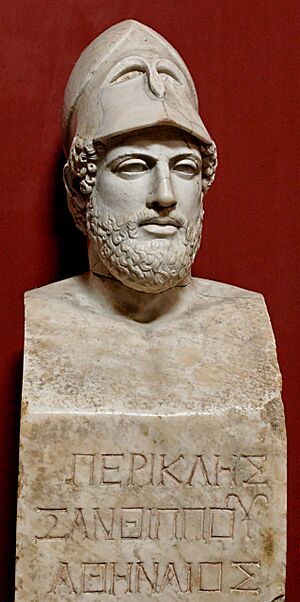Kresilas facts for kids
Quick facts for kids
Kresilas
|
|
|---|---|
| Born | c. 480 BC Kydonia, Crete, Classical Greece
|
| Died | c. 410 BC |
| Education |
|
| Known for | sculpture |
|
Notable work
|
|
Kresilas (whose name in Greek was Krēsílas) was a famous Greek sculptor. He lived during the Classical period in ancient Greece, which was around the 5th century BC. Kresilas was from a city called Kydonia on the island of Crete.
He learned his skills in Argos and later worked in Athens. This was during the time of the Peloponnesian War. Kresilas was known for making statues that showed people in an ideal, perfect way. He was especially famous for his statue of Pericles with the Corinthian helmet.
Contents
Who Was Kresilas?
Kresilas came from the city-state of Kydonia, which is located on the island of Crete. He first trained as a student of a sculptor named Dorotheos in Argos. Kresilas even worked with Dorotheos in places like Delphi and Hermione.
Between 450 BC and 420 BC, Kresilas mostly worked in Athens. He followed the style of another famous sculptor, Myron. His work also showed new ideas after the time of Phidias, another great sculptor. Kresilas added a sense of strength and seriousness to his art, which fit the mood during the Peloponnesian War.
A Famous Sculpture Competition
A Roman writer named Pliny the Elder wrote about an exciting competition. Four famous sculptors, Polykleitos, Phidias, Kresilas, and Phradmon, competed. They each wanted to create the best statue of an Amazon for the Temple of Artemis at Ephesus.
Each sculptor voted for their own statue as the best. But then, Phidias, Kresilas, and Phradmon all voted for Polykleitos's statue as second best. Because of this, Polykleitos won the competition. Phidias came in second place, and Kresilas took third place.
Kresilas's Amazing Artworks

In Athens, Kresilas created a bronze statue of Pericles. Pericles was an important leader and general (called a strategos) in Athens. The statue showed him wearing a Corinthian helmet, which was a symbol of his leadership.
Pliny the Elder said that this statue was "a work worthy of the title." He also wrote that it was "a marvellous thing about this art that it can make famous men even more famous." The base of this statue was found on the Athenian Acropolis. Many busts (head and shoulders statues) of Pericles that we see today are copies of Kresilas's original work. You can find examples in the Vatican Museums, the British Museum, and the Altes Museum.
Kresilas also created statues of wounded men and a dying Amazon for the competition in Ephesus. Many copies of these statues exist today. One famous example is the wounded Amazon of Kresilas in the Vatican Museums. People also believe he created the Athena of Velletri statue. This statue shows the goddess Athena. He also made a statue of Diomedes, a hero from Homer's epic poems.
The "Cresilla" Mix-Up
In 1804 CE, there was a misunderstanding about Kresilas. A writer named Matilda Betham mistakenly thought Kresilas was a woman named "Cresilla." She believed "Cresilla" had placed third in the Amazon sculpture competition.
Because of this mistake, Kresilas was later included in a famous art piece called The Dinner Party by artist Judy Chicago. This artwork celebrates important women in history. However, Kresilas was actually a man, not a woman named Cresilla.
See also
 In Spanish: Cresilas para niños
In Spanish: Cresilas para niños

